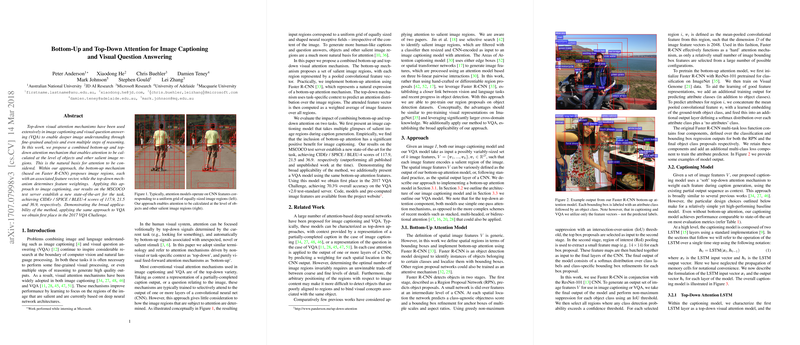Bottom-Up and Top-Down Attention for Image Captioning and Visual Question Answering
Overview
The paper "Bottom-Up and Top-Down Attention for Image Captioning and Visual Question Answering" addresses the incorporation of combined attention mechanisms to improve performance in image captioning and visual question answering (VQA). The proposed method integrates bottom-up attention, derived from Faster R-CNN region proposals, with traditional top-down attention to target object-specific and salient image regions more effectively.
Methodology
Bottom-Up Attention Mechanism:
The bottom-up attention mechanism is implemented using Faster R-CNN, a prominent object detection model. This model processes an image in two stages: first, it generates region proposals, and second, it assigns a class label to each region and refines the bounding boxes.
Key steps include:
- Region Proposals: The Region Proposal Network (RPN) generates object proposals.
- Region of Interest (RoI) Pooling: Extracts feature maps for each proposal.
- Object Classification and Bounding Box Refinement: Predicts class labels and bounding boxes for the proposals.
The resultant object regions serve as attentive regions, each represented by pooled convolutional feature vectors.
Top-Down Attention Mechanism:
The top-down attention mechanism processes image features combined with task-specific context, such as partial caption sequences in image captioning or question representations in VQA.
Image Captioning Model
Architecture:
The proposed image captioning model employs two LSTM layers:
- Top-Down Attention LSTM: Generates attention weights for each region based on the hidden states and context.
- Language LSTM: Generates the final output word based on attended image features and the hidden states from the top-down attention LSTM.
Training:
The model is initially trained using cross-entropy loss, followed by optimization for CIDEr score using a self-critical sequence training (SCST) approach, enhancing the fluency and relevance of generated captions.
Visual Question Answering Model
Architecture:
The VQA model utilizes a GRU to encode the question, followed by a top-down attention layer that weights image features based on the question representation. The resultant attended features are integrated with the question encoding to predict the answer.
Training:
Training includes data augmentation with Visual Genome questions, enhancing the learning of varied question types. The model is optimized using the AdaDelta algorithm and regularized with early stopping.
Results
Image Captioning:
The combined bottom-up and top-down attention model outperforms the ResNet baseline in image captioning tasks, establishing new state-of-the-art results on the MSCOCO Karpathy test split. Notably, the model achieves significant improvements in CIDEr, SPICE, BLEU-4, and other metrics. Ensemble methods further enhance performance on the MSCOCO test server.
Visual Question Answering:
In VQA tasks, the proposed model demonstrates substantial improvements over ResNet baselines, particularly excelling in questions requiring counting and specific attribute recognition. The model attains the highest accuracy on the VQA v2.0 test-standard evaluation server and secures first place in the 2017 VQA Challenge.
Implications and Future Directions
This work bridges the gap between advancements in object detection and multimodal understanding, suggesting a path for more sophisticated and interpretable AI models. Future research could extend this approach by refining region proposals and incorporating additional contextual information, potentially leading to further improvements in both image captioning and VQA. Additionally, exploring different neural architectures (e.g., transformers) for the attention mechanisms may enhance performance and scalability.
In conclusion, the integration of bottom-up and top-down attention mechanisms offers a considerable advancement in the interpretability and efficacy of multimodal AI tasks. The implications of this research underscore the importance of object-specific attention in improving AI systems' understanding of visual and linguistic contexts.
